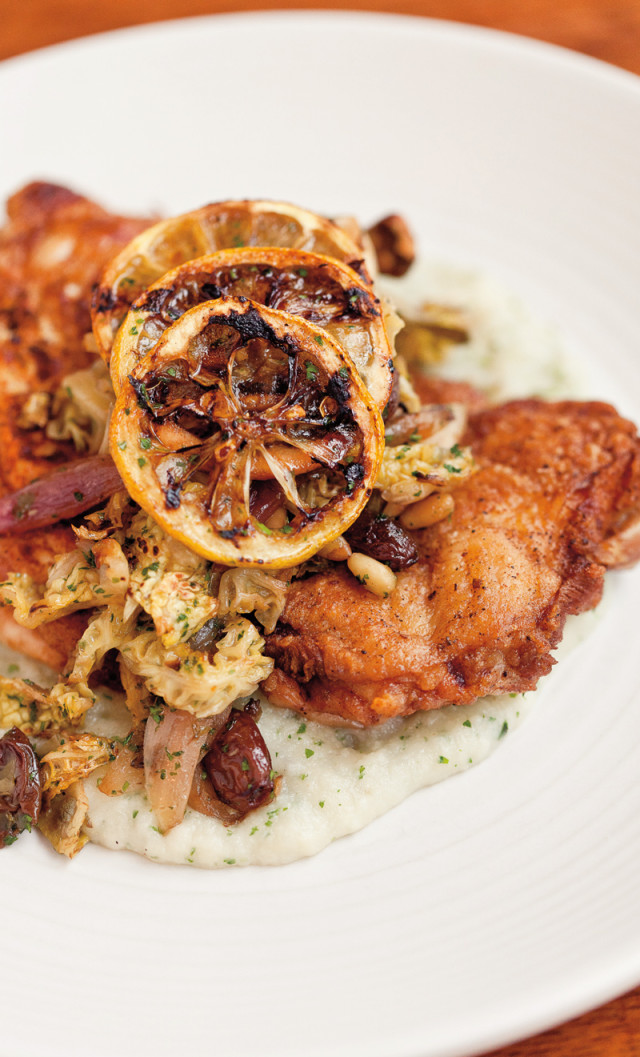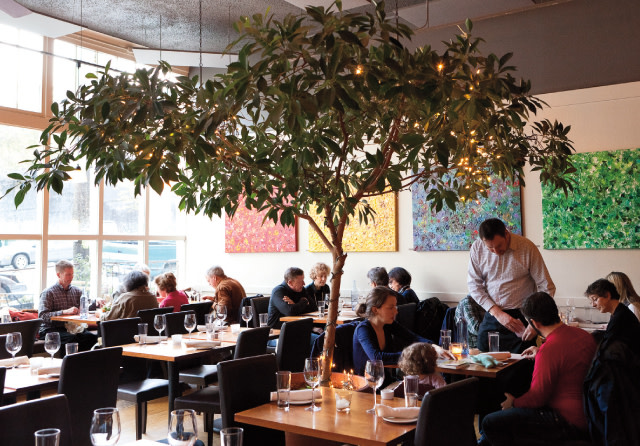Certifiably Sweet and Sour

Lemon Is Essential Sweet-sour agrodolce over roasted chicken and semolina pudding
Image: Olivia Brent
When you’re a chef and you run out of flour, you send someone out for it. When you’re Maria Hines and you run out of flour, it’s a problem of a different magnitude.
Hines—James Beard Best Chef in the Northwest award winner and proprietor of Tilth and Golden Beetle—opened Agrodolce in the last days of 2012. She was going for something between her first two restaurants: not the French-inspired Tilth nor the Middle Eastern Golden Beetle, but the Sicilian cuisine that lies between them geographically and borrows from both culinarily. She was also aiming to get Agrodolce approved by the same strict standard--bearer, Oregon Tilth, by which her two other restaurants had been certified organic.
To achieve that level of virtue, Agrodolce’s chefs had taken to sourcing organic durum wheat berries from Idaho’s Purcell Mountain Farm, then milling them into the semolina flour they use to make the pastas by hand. I repeat: milling them into the semolina flour they use to make the pastas by hand. So alas, when Purcell Mountain not long ago ran out of wheat berries, there was no simple fix. “Usually when your source is out of something, you change your menu,” Hines says. “But this was wheat. In a pasta restaurant.”
With alarming resourcefulness (the kind that gets you pegged as a Rising Star, see page 77), Hines’s right-hand chef Jason Brzozowy managed to track organic durum wheat berries to a little survivalist store in Montana. Survivalist indeed. The tale illustrates the challenge of running a restaurant with sourcing and preparation standards as rigorous as Hines’s.
And so, as it happens, does Agrodolce.
The high-ceilinged space is as gracious as it was at Still Life in Fremont, then later as the dear departed 35th Street Bistro. By day—the place is open lunch or weekend brunch through dinner—sunlight streams through floor-to-ceiling windows, illuminating rows of two- and four-tops. From the center of the room a ficus tree unfurls leafy branches over diners’ heads. In back sits a small bar and a cozy sitting room with couches and a chandelier. Compared to Tilth’s funky farmhouse feel and Golden Beetle’s homemade aesthetic, pretty Agrodolce with its comfortable seats is the first Maria Hines restaurant you want to linger in.
We arrived in the thick of Friday-night dinner, landing in a din that compelled us to stop talking and dive directly into the menu. (Rethinking the lingering.) Divided into starters, pastas, mains, and vegetables, the preparations showcase the gastronomic melting pot that is Sicily: plenty of citrus and olives and tomatoes with the Arab inflections of pine nuts and capers and raisins. We began with the Sicilian specialty of fried rice balls, or arancini, crisp and yielding to a meaty ragu filling that spilled flavorfully across a puddle of parsley pesto.
A wild arugula salad made glorious eating, its heaping tangle of bitter greens punctuated with dollops of ricotta salata, red pepper, croutons, bursting jewels of blood orange, and fragrant herbs. It offered a sense of unrestrained abundance that is rare at Agrodolce, a kitchen so circumscribed by its organic mandate that innovation stays within bounds, and—to remain affordable—portions trend small (particularly at brunch) and ingredients few.

A Place to Linger Sunlight streams in through the windows, and a ficus tree unfurls its leafy branches.
Image: Olivia Brent
Perhaps this is what makes some dishes so uneventful. A brunchtime sticky bun was standard-issue pecan with caramel and golden raisins. Both a bowl of slow-cooked rabbit cacciatore, made with the Sardinian semolina pasta balls called fregola, and a duck cavatelli made with Marsala, wild mushrooms, and toothsome pancetta grew tedious by meal’s end. The cavatelli was disappointing in part because I couldn’t help but contrast its strong Marsala flavor with the richer, more nuanced rendition at Altura on Capitol Hill.
Considering Agrodolce’s labor in simply making many of the pastas—milling the wheat berries, milling them again, blending them in a special grinder, straining the grain to achieve the finest flour consistency, crafting the pasta—perhaps the further work of perfecting the harmonies proved too much. I wondered: Were other problems we encountered—the salty filling in the truffle-ricotta ravioli, the chalkiness of the orange dessert cannoli, the dryness of the brunch citrus-semolina pancakes—the result of prioritizing execution last? Who has time for consistency when you’re twice milling your wheat berries?
Right about the time this thought occurred, we hit a string of winners. A robust spaghetti—a noodle that’s almost never handmade, but is here, with satisfying density—came powered by Mama Lil’s peppers and a Skagit River Ranch beef sugo. Better still was a brilliantly conceived dish of ragged-edged hand-cut tagliarini pasta strands doused in a briny cream of uni, or sea urchin, and clam. Pine nuts and romanesco, that weirdly intergalactic cauliflower-slash-broccoli, here cut into bits, rounded the flavors intelligently, with an essential squeeze of lemon.
When this kitchen’s on, it’s on. My favorite meal at Agrodolce exemplified its name—Italian for sweet and sour. A brined half chicken, pan seared and braised in chicken stock, was topped with a vinegary caponata of wizened Brussels sprouts leaflets, along with garlic, pine nuts, and golden raisins—classic agrodolce—served over creamy semolina puree. The flavors were collaborative and original, but the more improbable success was the perfect texture of the chicken, achieved without the sous vide machine that’s usually responsible when chicken is this moist. “No toys in my kitchen!” Hines declared, crediting Brzozowy for the dish. Chunks of quick-fermented and slightly sour focaccia, housemade of course and served with bracing Sicilian extra-virgin olive oil, were winning with a couple of vivid contorni—seared broccoli in an anchovy vinaigrette and juicy lacinato kale with chili flakes.
One final note about service. Waiters maintain an obvious rapport with one another, which creates a happy house for diners. There is, bravo, salt on the table. That said, service problems ranged from the delivery of unfortunate brunch toast—could anything cast more of a pall over morning hospitality than cold unbuttered toast?—to the same minimalist menu descriptions that plague Hines’s other houses. A “pear and apple salad” was less a salad than an artfully composed yogurt plate with fruit for punctuation, along with a dollop of raisiny mostarda.
Here was an organic dish, gorgeously plated, original in conception, supremely tasty: in short, Hines’s proudest calling card. In a house where the organic mandate can be constricting, you’d think she’d want to shine the brightest spotlight possible on the extravagant delights it can afford.
Published: June 2013



